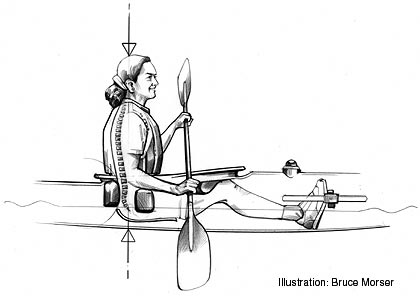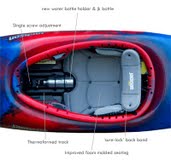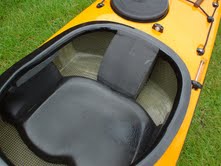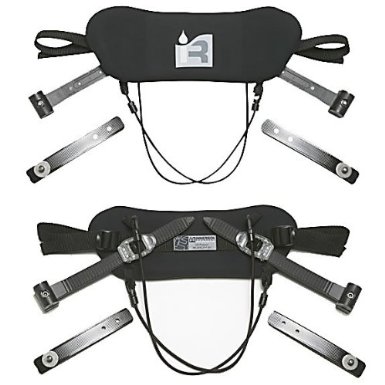With so many different makes and models of kayaks out there, it follows that there are just as many types of outfitting. Outfitting is one of the key factors affecting the performance and usability of any kayak. Properly fitted, outfitting allows the efficient transfer of energy from the paddler to the boat, via the paddle blades. As such an important component of the boat, it is important that paddlers understand the different types of outfitting they may encounter and how to properly adjust it for comfort mile after mile.

A paddler with good posture is sitting up straight. The backband and foot pegs (or foam) are adjusted to facilitate good posture without fatigue.
Whitewater Outfitting
The best place to start to understand the effect of outfitting on kayak performance is in the world of whitewater. Whitewater paddlers rely on a snug fit to paddle with maximum control-just like sea kayaking, the majority of the paddler’s stability and control comes from the torso and hips, not the shoulders and arms.

The seat, backband and hip pads can be seen here, in a boat from Jackson Kayak.
The components of whitewater outfitting that are common across models are the seat, thigh braces, backband, hip pads, and foot foam. All of these components are adjustable; some (the seat & thigh braces) are adjusted for the boat’s owner and then generally left alone, while others (the backband & foot foam) are adjusted each time the boat is paddled.
Whitewater outfitting has come a long way since the days when it was common to purchase just the boat’s hull, and custom-build the closed-cell outfitting from the ground up. It’s rare for this approach to be utilized today, however it is still a great way to revamp that classic garage sale find. Almost all new kayaks today come with a (sometimes) substantial kit containing additional foam pieces to get the perfect fit. It’s important to remember that whitewater boats are tools to do a very specific job, and to accomplish this they need to be fitted properly.
Sea Kayak Outfitting

A composite sea kayak featuring a molded seat pan and custom-shaped back support.
Seats in sea kayaks seem to become less substantial as the price of the boat increases. This is by design-anyone serious about the performance of their boat understands that some customization is required. Don’t be afraid to add some mini-cell foam where you need it.

The IR Reggie Backband can be installed in a surprising number of kayaks of various designs.
The best sea kayaks (in my opinion) feature backbands. These are low profile, easily adjusted and function as the glue that holds the paddler in contact with the seat, thigh braces and foot pegs. There are excellent after market backbands available that are easily installed in most, if not all, whitewater and sea kayaks. Some examples are the Immersion Research Reggie and Loungeband.
Beware of sea kayak outfitting with an overly technical appearance. It is often said on the sales floor that the recreational kayak is “sold on its seat”. Some of this same mentality has leaked over into the sea kayak market, especially in the realm of ‘Light Touring’. Any boat with a seat or outfitting reminiscent of a high-tech lawn chair should be avoided, as it will sacrifice performance (and secondary stability) for initial comfort.
Take some time to learn how your outfitting works best for you. Don’t be afraid to experiment with the various components or to foam out the hot spots. It’s amazing how big of an improvement you can make in your paddling life with a sharp knife, some contact cement and a little creativity.
Happy Paddling!
Keith


